Goro
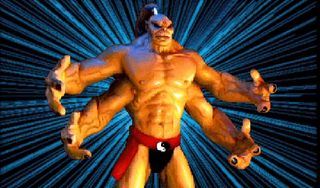
Once all the “mortals” were taken care of, the final kombatant (and reigning MK champion) was a half-human, half-dragon, four-armed monster called Goro. He was a huge, intimidating beast that spewed monstrous noises and could whittle your life bar away in no time. In short, he was a fantastic final boss, one that really sold the idea of Mortal Kombat – fighting for your life, thinking you’ve won and then watch as victory is snatched from your grasp.
Obviously Goro wasn’t a human actor; he was a stop-motion puppet, digitized into the game for a one-of-a-kind boss battle. There was nothing else quite like it at the time – Pit Fighter may have had scanned actors clumsily banging away at each other, but only MK had a creature seemingly plucked from The Nightmare Before Christmas.

Above: WHY WOULD YOU GET CLOSE TO HIM
Signature move: Goro had few moves period, but each dealt insane amounts of damage. Most notable was his grab, which held you up with two arms and then caved your chest in with the other two. It quickly teaches you a lesson – stay away!

Fatality: Strangely, Goro has no finishing move, nor can you perform one on him. Guess they didn’t want to mess up that fancy puppet?
Above: Trained to fight… to conquer… to RULE!
Shang Tsung

Tsung was once the champion of Mortal Kombat…till Kung Lao put an end to his shindig a few hundred years ago. Pissed, Tsung showed up with Goro a few years later to dominate the tournament and won nine in a row. It’s suggested if a 10th is won… well then we’ve got problems. Weird alternate dimension invasion problems.
Tsung can morph into any of the other fighters (including Goro) and use their moves against you. It’s a neat effect, one that really sells the idea of fighting a powerful sorcerer, but from a gameplay perspective it’s kind of a cop out – rather than create a true final boss with his own moves, we basically get to fight the same cast all over again.
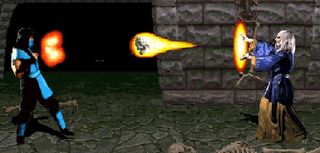
Above: But he does have this move, at least
Signature move: Obviously his morphing ability steals the show, but it’s not really a “move.” That honor would have to go to Tsung’s triple fireball attack, which spams the screen with flaming skulls that deal insane damage. Pretty capable for an ancient wizard.
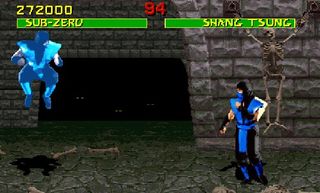
Fatality: As with Goro, Tsung had no fatality. He’s just there to make sure the Earthrealm fighters lose and his master (Shao Kahn) can invade Earth and set the stage for MKII and MK3.
Above: Strangely, Tsung has no theme song. So here’s the generic “Techno Syndrome” we’ve heard nonstop for the past 15 years
While he doesn’t compare to Goro (who really stole the show as “memorable boss fight”), Tsung himself put a worthy cap on the game. Rather than show up out of nowhere like M. Bison at the end like Street Fighter II, Tsung is there from the start, arranging the tournament and shouting “Finish Him!” at the end of every match - and you don’t have to read a character ending to know he’s evil.
Reptile

Not content with two palette swapped ninjas, the MK team tossed in a third, secret martial artist who was only accessible after certain criteria were met. Meeting Reptile wasn’t easy; you had to wait until a silhouette flew across the moon on the Pit level, and then win two perfect victories, never touch the block button and perform a fatality. All this just to fight a green ninja with moves stolen from Sub-Zero and Scorpion!
Reptile marks another major innovation MK brought to the fighting scene – copious hidden content. Street Fighter II, while immensely popular, had everything laid out from the start. MK, on the other hand, cleverly hid an entire character in plain sight, one who would randomly appear before matches and then vanish. Who was this green ninja, and how do you fight him? Can you play as him? Such mysteries made MK even more compelling, again despite the comparatively shallow gameplay.

Above: A hidden character? Unheard of!
So strong was the allure of being the first to discover the next “hidden” character that rumors would wildly spread from arcade to arcade. Years before the internet or games sites existed, all we had was word of mouth and month-late magazines. Which rumors were true? Which were not? Speculation like this made MK a hot topic for years. Some rumors, like Ermac, become real characters later in the series, so that alone should give you some idea of how ravenous we all were for MK info.
The backgrounds

Like we said before, the first MK felt like a playable martial arts movie. This sensation was furthered by the game’s backdrops, which all reinforced the “tournament” vibe; the image above features stone statues of the MK fighters, suggesting this is indeed an important enough battle to warrant such extravagance; below you’ll see the main theater area, which features Shang Tsung atop a throne surrounded by a sea of onlookers. Definitely felt like a momentous occasion and not just a street fight.
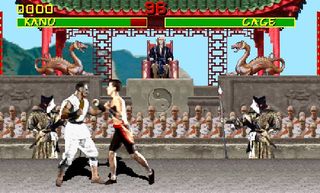
The most popular backdrop was undoubtedly The Pit, which was referenced earlier in the Reptile entry. Here lied yet another secret – instead of performing a fatality, you could uppercut the opponent off the narrow bridge and send them screaming into a spike-ridden ditch, which was itself filled with rotting bodies and severed heads.
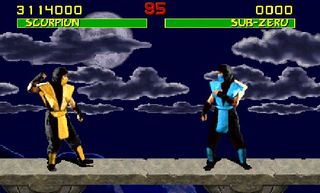
Above: The top of the Pit, where you could slightly seen beneath the walkway
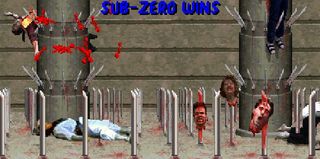
Above: The bottom of the Pit, which happens to feature the severed heads of devs Boon, Tobias and John Vogel
On top of being a cool way to end a fight, the Pit (and these other stages) further distanced themselves from the Street Fighter way of doing things. In SF, each fighter had his or her own background, theme song and country of origin. In MK, the tournament is much more organized and official, and all takes place on one island where all the fighters must gather. Again, all these small details come together to create an atmosphere of mystery, violence and impending doom.
